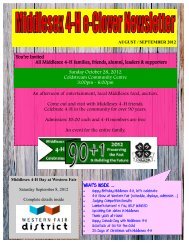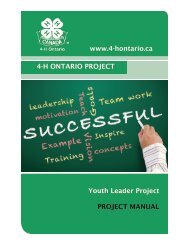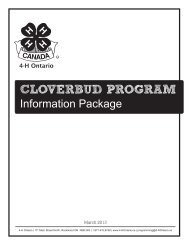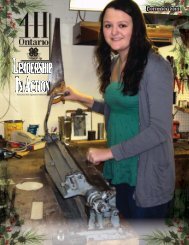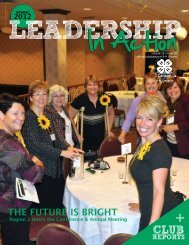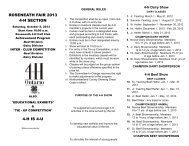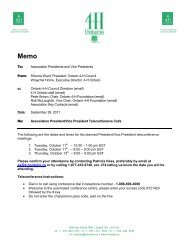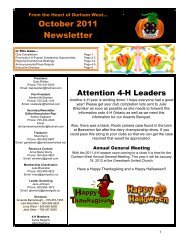2013 Resource Guide - 4-H Ontario
2013 Resource Guide - 4-H Ontario
2013 Resource Guide - 4-H Ontario
Create successful ePaper yourself
Turn your PDF publications into a flip-book with our unique Google optimized e-Paper software.
ABOUT 4 H<br />
WHAT IS 4-H?<br />
“<br />
4-H is community building in its<br />
most sincere sense… volunteers<br />
learning and guiding youth to<br />
explore and gain knowledge in<br />
real, practical ways.”<br />
LEARN TO<br />
Camps, conferences and exchanges are available in which<br />
4-H is a grassroots organization of leaders building<br />
leaders. 4-H emphasizes the importance of looking at the<br />
big picture; that youth need to see beyond themselves and<br />
focus on how their actions affect their relationships, their<br />
community, the environment and society as a whole.<br />
This belief is reflected in the 4-H pledge, said at the beginning<br />
of every 4-H meeting and event. The 4-H pledge<br />
encourages a balanced lifestyle (intellectual, emotional,<br />
physical and spiritual), and reminds participants to aim to<br />
be a good friend, mentor, community member and citizen.<br />
4-H is based on a “Learn To Do By Doing” philosophy.<br />
Members aged 9–21 and volunteer leaders come together<br />
to create a 4-H club, where members learn about a selected<br />
topic through hands-on activities and mentorship. In<br />
the Cloverbud program, participants aged 6–8 work with<br />
volunteer leaders on a variety of units over a full year.<br />
4-H activities and clubs are structured to develop leadership<br />
skills including public speaking, communication,<br />
decision making, parliamentary procedure, meeting management<br />
and networking, while also educating members<br />
about the club subject matter. These leadership and life<br />
skills, equip 4-H participants to reach their full potential,<br />
becoming conscious and contributing citizens.<br />
The 4-H club is a safe environment that fosters personal<br />
growth and development. 4-H encourages team collaboration,<br />
peer-to-peer support and independent learning.<br />
Leaders guide members through activities, yet provide<br />
them with the freedom to make their own mistakes and<br />
assist one another in the learning process.<br />
To supplement learning that occurs at the club level, 4-H<br />
provides provincial and national opportunities, enabling<br />
members to further expand their knowledge and horizons.<br />
—Wraychel Horne, Executive Director, 4-H <strong>Ontario</strong><br />
4-H members and young 4-H alumni may participate. Many<br />
camps and conferences are open to all interested youth—<br />
not just 4-H members and participants.<br />
4-H works to provide a safe and welcoming environment<br />
for all youth. The 4-H approach to learning, development<br />
of life skills and leadership, and a focus on community<br />
involvement, makes the 4-H program unique.<br />
THE 4-H CLUB<br />
4-H clubs are comprised of a minimum of six 4-H members<br />
and two trained, screened volunteers who act as club<br />
leaders. The club decides on a topic and through leader<br />
instruction and hands-on learning, members spend 12<br />
hours exploring the topic during 4-H meetings. 4-H members<br />
and volunteers can belong to as many clubs as they<br />
wish. Topics include cooking, woodworking, camping,<br />
building a healthy body image, drama, agricultural business<br />
management, photography and much more.<br />
4-H CLUB MEETINGS<br />
4-H clubs typically come together for six two-hour meetings.<br />
The meetings are organized by the club volunteers<br />
(also known as leaders) and learning content can take<br />
many forms—tours, guest speakers, demonstrations,<br />
activities, etc.<br />
4-H meetings are structured with formal meeting time and<br />
hands-on learning time. The formal meeting time is often<br />
referred to as the “business portion” of the meeting. In<br />
the formal meeting time, 4-H’rs discuss club issues and<br />
opportunities, while also learning about parliamentary<br />
procedure.<br />
Once club “business” has finished, members are guided<br />
by leaders and fellow members in hands-on activities.<br />
Meetings are typically wrapped up with social recreation<br />
and snacks.<br />
Members must participate in at least two-thirds of the<br />
club meeting time and participate in the Club Achievement<br />
Program to have successfully completed the club project.<br />
THE CLUB EXECUTIVE<br />
Each club has a variety of executive positions. These<br />
positions work with each other, and other club members,<br />
to accomplish goals set by club members. They also help<br />
guide meetings to ensure everything runs smoothly. The<br />
4 <strong>2013</strong> 4-H ONTARIO RESOURCE GUIDE



